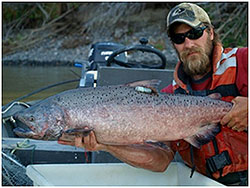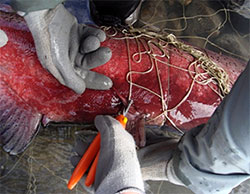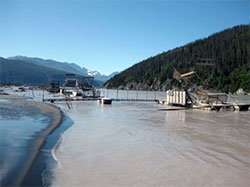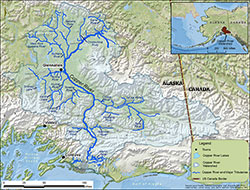Chinook Salmon Research Initiative
Copper River Chinook Salmon
Copper River
Overview
The Copper River is a large, glacially-fed river system that drains 61,440 square kilometers (23,722 square miles) and is the fifth largest watershed in Alaska. The Copper River Chinook salmon population supports a marine commercial gillnet fishery near the mouth of the river plus inriver subsistence, personal use, and sport fisheries.
Chinook salmon returning to the Copper River drainage pass through the Copper River Delta and begin to enter the Copper River in early May. The peak timing in the Lower Copper River is from mid-May to mid-June, with the return essentially complete by July 1. However, small numbers of Chinook salmon continue to enter the Copper River through August. Chinook salmon make their way to spawning areas in the Upper Copper River tributaries through June and July and spawn mid-July through August.
Prior to 1999, Chinook salmon escapement was measured with peak aerial survey counts in nine index streams and there were no formal escapement goals. Beginning in 1999, a mainstem mark-recapture project was initiated by the Alaska Department of Fish and Game to estimate total inriver abundance of Chinook salmon in the Copper River. This project has continued annually since then, and is now being conducted by the Native Village of Eyak. Escapement estimates are calculated post-season by subtracting estimates of inriver harvest from the inriver mark-recapture abundance estimate. Currently, the Copper River Chinook run is managed for a total drainage sustainable escapement goal of 24,000 or more fish.
In order to better understand the processes affecting production of Chinook salmon in the Copper River and to better facilitate management of the fishery, additional information regarding adult and juvenile abundance, stock composition of the harvest and traditional knowledge of the fisheries is needed.
Adult Spawning Abundance

The Copper River Chinook salmon stock is composed of six major spawning stocks. Upriver stocks, like the Gulkana and Chistochina, are genetically distinct and exhibit early run-timing patterns; these stocks are targeted by fishers because of their early entry in to the river and importance to commercial, subsistence, personal-use, and sport fisheries. Gulkana River Chinook salmon comprise an average of 21% of the Copper River drainage Chinook salmon spawning population and over 29% of the Chinook salmon available to upper Copper River subsistence fisheries. The Gulkana River Chinook salmon distribution study, in conjunction with the counting tower that estimates upper Gulkana River escapement, will provide a method to estimate the total escapement of Chinook salmon on a highly utilized stock and is the only method to assess the inseason progression of escapement for any individual Chinook salmon stock in the Copper River drainage. Since 1999, escapements have averaged just over 29,500 Chinook salmon, just above the escapement goal of 24,000. In these 15 years the run has failed to attain the escapement goal only 4 times. In addition, a time series of these total escapement estimates can be used to establish the only escapement goal for any major spawning tributary in the Copper River drainage. This inseason monitoring combined with anecdotal harvest data from the various upper Copper River fisheries is vital to managers when making decisions about the Copper River’s important subsistence, personal-use, commercial, and sport fisheries.
The study area is the Gulkana River drainage, from its confluence with the Copper River to spawning locations of radiotagged Chinook salmon. Radiotagging will take place in the lower river from the Richardson Highway downstream to the confluence with the Copper River, a distance of approximately 7 km (4 miles). The majority of the sampling will take place at the confluence with the Copper River. Five radio tracking stations and numerous aerial tracking surveys will be used to estimate the distribution of spawning Chinook salmon above and below the established counting tower maintained cooperatively by the Alaska Department of Fish and Game and the U.S. Department of Interior, Bureau of Land Management. The combination of these distribution estimates will be used to derive estimates of total escapement.
Juvenile Abundance

In spring 2014, the Alaska Department of Fish and Game, Division of Sport Fish will be initiating the first phase of a multi-year juvenile salmon coded wire tagging study. It is hoped that this study will ultimately provide estimates of the annual abundance of Chinook salmon smolt emigrating from the Copper River and their subsequent marine survival. Estimates of smolt abundance and survival provide information about processes like recruitment and mortality that is needed to understand the causes of variability in Chinook salmon returns. In order to estimate smolt abundance, outmigrating smolt are tagged in the spring and then spawners returning from that particular brood or parent year over all age classes (3 to 7 years) are sampled and the number of outmigrating smolt is estimated based on the fraction of adult fish that have tags. However, before a project of this magnitude is funded, a study to assess the feasibility of capturing emigrating smolts from the Copper River is required. Currently, there is little information on the outmigration timing of Chinook salmon smolts from the Copper River. Studies on the Unalakleet River in western Alaska have shown that Chinook salmon smolt begin their outmigration under the ice; however, studies throughout Southeast Alaska have not encountered this situation, and in those studies researchers have been consistently able to capture and tag adequate numbers of Chinook salmon smolt. On the Copper River, it is unknown whether ice and/or snow conditions during the spring salmon smolt outmigration will preclude effective sampling of Chinook smolts due to the impracticality of sampling through the ice and/or safety concerns during periods with large ice-flows. To increase the chance of sampling smolts under these conditions, two areas on the Copper River will be sampled for emigrating Chinook salmon smolt. The first area is on the mainstem Copper River downstream from the confluence of the Chitina River, and the second area will be on the Copper River Delta centered near the 25-Mile Bridge crossing.
Sampling during the spring of 2014 will be conducted from approximately mid-May to mid-June. Minnow traps baited with salmon roe and beach seines will be used to capture emigrating Chinook salmon smolts just as has been done in Southeast Alaska studies since 1999. During this first year, crew sizes will be fairly small: one crew of 4 people will work in the upper area and one crew of 4 people will work in the Delta area. During this first year of the study, no fish will coded wire tagged; rather, the main goal will be to determine effective capture methods, suitable sampling sites, and run timing so that a more intensive and efficient sampling scheme can be implemented in Spring 2015. Depending on the success of the spring smolt sampling, fall sampling of juveniles from the major spawning streams may be conducted as a means to coded wire tag additional fish.
Marine Sampling
Chinook salmon are harvested in subsistence, commercial, sport, personal-use fisheries throughout the Copper River drainage and in nearshore marine waters. On average, 72% of the harvest has been taken in the Copper River District commercial fishery from fish returning to a variety of tributaries in the drainage (Botz et al. 2010 - PDF 2,879 kB). However, the harvests and abundances of individual stocks are not well known. The Copper River currently has 49 documented spawning locations for Chinook salmon (Johnson and Blanche 2011 - PDF 4,123 kB).
The Alaska Department of Fish and Game management strategy for the Copper River District salmon commercial fishery is to provide inriver passage for all time segments (and presumably stocks) of the overall run. Thus harvests have generally been managed with two evenly-spaced fishery openers each week (Botz et al. 2010 - PDF 2,879 kB). However, until recently very little information was available to demonstrate run-timing differences among the six Copper River Chinook salmon stocks.

The first studies to examine run timing in Copper River Chinook salmon were radiotelemetry projects which provided information on inriver timing to many systems in the Upper Copper River (Wuttig and Evenson 2001; Savereide 2005 - PDF 311 kB). In these studies, adult Chinook salmon were captured and tagged at the Baird Canyon fishwheel sites, then tracked to upriver spawning locations. These studies provided information not only on run timing, but also on spawning distribution and abundance within the drainage and demonstrated that upriver populations were present in the river earlier than downriver populations. While radiotagging studies described run timings within the Copper River, the timings of these components in commercial harvests were unknown. Estimates of stock compositions at the Baird Canyon fishwheel from tags or genetic markers could be extrapolated downstream to the Copper River Delta by making several assumptions and applied to the harvest, but these assumptions could not be validated by direct measurement.
To develop the capacity to estimate run timing and harvest of Chinook salmon run components in the commercial fishery, the Alaska Department of Fish and Game started the development of a genetic baseline in the Copper River in 2004 (Seeb et al. 2009 - PDF 761 kB). This baseline contained approximately 1,650 individuals from 16 spawning areas across the drainage, and indicated that populations could be separated into three broad geographical groups: the Upper Copper River, the Gulkana River drainage, and a diverse set of populations in the Lower Copper River glacial lakes. The utility of this baseline for genetic stock identification was demonstrated with samples from Baird Canyon and the 2005 Copper River District commercial fishery. While utility for genetic stock identification estimates within the Copper River drainage was demonstrated, the baseline could not be used for management in the Copper River District until the inriver baseline data could be combined with data from more distant populations.

The central location of the Copper River in the Gulf of Alaska and long migrations of Chinook salmon require a comprehensive baseline of populations across the North Pacific Ocean (Alaska Peninsula to California) to provide accurate genetic stock identification estimates in the Copper River District commercial fishery. When the first fishery samples were analyzed in 2006, microsatellites were chosen as the marker due to the existence of a more comprehensive baseline already developed for the Pacific Salmon Commission (Seeb et al. 2007 ![]() ). This baseline could be combined with baseline-development projects by the Alaska Department of Fish and Game in Southeast Alaska, in the Copper River, and in the Kenai River. Since 2006, a baseline using single nucleotide polymorphisms (SNPs) has been developed (Templin et al. 2011
). This baseline could be combined with baseline-development projects by the Alaska Department of Fish and Game in Southeast Alaska, in the Copper River, and in the Kenai River. Since 2006, a baseline using single nucleotide polymorphisms (SNPs) has been developed (Templin et al. 2011 ![]() ) and applied to marine samples (Larson et al. 2013
) and applied to marine samples (Larson et al. 2013 ![]() ). For the Alaska Department of Fish and Game, single nucleotide polymorphisms or SNPs are now the marker of choice because of their rapid turnaround times for inseason mixed-stock analysis of harvests.
). For the Alaska Department of Fish and Game, single nucleotide polymorphisms or SNPs are now the marker of choice because of their rapid turnaround times for inseason mixed-stock analysis of harvests.
This project will apply the available baseline of genetic information representing Chinook salmon populations within the Copper River drainage, around the Gulf of Alaska, and in southern areas to estimate the relative stock compositions of Chinook salmon harvests in the commercial fishery in the Copper River District from 2013 to 2016. It will also screen for possible coded wire tagged fish captured in the fishery. This project may continue into 2018 with the same objectives.

Subsistence

The Subsistence Section will investigate the local and traditional knowledge of Chinook salmon in the Copper River. The relationship between households’ involvement in commercial fishing and harvests of Copper River Chinook salmon and other resources for home use in Cordova will be studied. Research methods will include a systematic household survey, key respondent interviewing, and participant observation. Results will include estimates of the number of salmon retained from commercial harvests for home use (the “home pack”), and an evaluation of current administrative procedures for estimating this harvest. Local and traditional knowledge about Copper River Chinook salmon will also be collected during interviews.
- Google+


